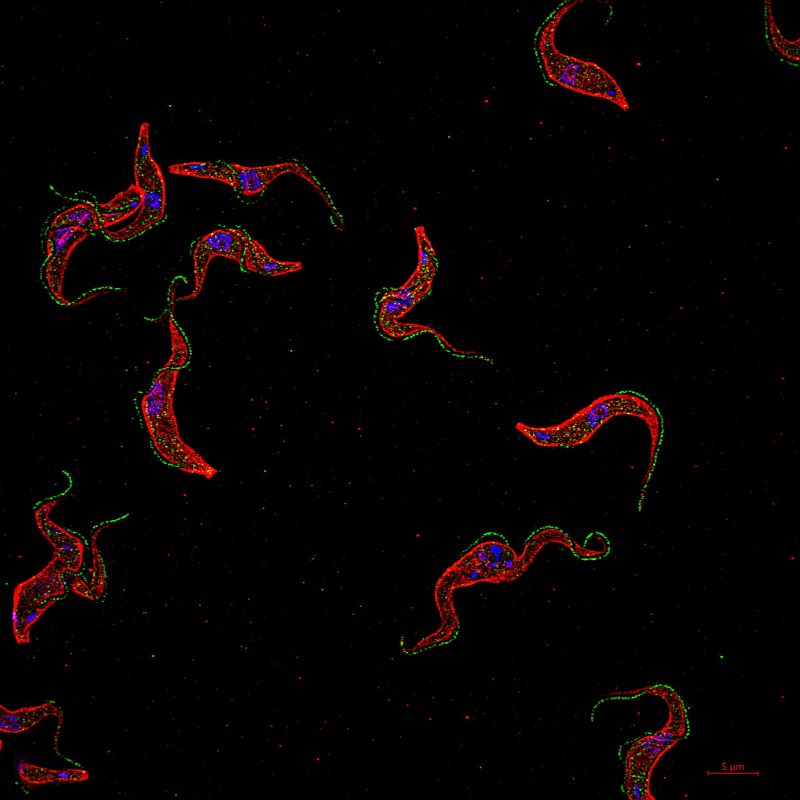About us

Our laboratory studies single cell parasites, primarily Leishmania and the related African trypanosomes. Leishmania parasites are responsible for the widespread group of neglected infectious diseases collectively called leishmaniases (e.g., visceral leishmaniasis and cutaneous leishmaniasis), which afflict an estimated 12 million people globally. The related African trypanosomes, Trypanosoma brucei, cause African sleeping sickness in humans, a lethal disease, and nagana, an important veterinary disease in cattle.
Parasites are microorganisms that live within hosts and rely upon them to provide a plethora of nutrients essential for the survival of the microbe. Hence, a core requirement of the parasitic mode of existence is the ability to efficiently acquire nutrients from both the vertebrate host and the invertebrate vector, usually an insect. A long-term interest of our laboratory has been parasite membrane transporters, which are integral membrane proteins that mediate the uptake across the surface membrane of specific nutrients from the extracellular environment. While studying parasite membrane transporters, we observed that some of them are selectively targeted to the membrane of the flagellum, a whip-like organelle important for parasite motility. However, the flagellum plays many other central roles in parasite biology, one of which is to sense the parasite’s extracellular environment and report upon it. How the flagellum carries out these and other activities is still poorly understood. However, many flagellar activities are dependent upon the proteins that are selectively targeted to the highly differentiated and unique flagellar membrane. Our current work focuses on two problems related to parasite flagella: 1) how are a specific subset of proteins selectively targeted to the flagellar surface membrane? 2) what are the biological functions of specific flagellar membrane proteins that allow the flagellum to carry out its diverse activities?
A second major but distinct project investigates the neddylation pathway in Leishmania parasites, an essential process whereby the small ubiquitin-like protein NEDD8 is covalently attached to substrate proteins and acts as a regulatory signal that controls the global composition of the parasite proteome. Neddylation is thus a central, and essential, regulatory pathway controlling which proteins are expressed under different physiological conditions or in different life cycle stages. This pathway has been an important target in mammalian cells for development of anti-cancer drugs, and in collaborative work we are targeting the Leishmania neddylation pathway for development of novel urgently needed anti-leishmanial drugs.
Neddylation is thus a central, and essential, regulatory pathway controlling which proteins are expressed under different physiological conditions or in different life cycle stages. This pathway has been an important target in mammalian cells for development of anti-cancer drugs, and in collaborative work we are targeting the Leishmania neddylation pathway for development of novel urgently needed anti-leishmanial drugs.
In both of the above undertakings, we employ a broad array of approaches, including biochemistry, molecular biology, genetics, cell biology and microscopy, proteomics, chemical biology, computational biology, pharmacology, etc. to investigate these processes at the molecular and cellular levels. Such diverse and interdisciplinary studies require close collaborations with various other laboratories both at OHSU and at other locations around the world. Furthermore, our laboratory promotes close interactions and collaborative work between members of our group as well as with collaborators elsewhere.
Traditionally, our research has focused upon the basic biology and biochemistry of these parasites. More recently, we have also engaged in drug discovery against these parasites, either by targeting the essential neddylation pathway mentioned above or by screening large chemical libraries for compounds that kill the parasite by any mode of action (phenotypic screens). In turn, these drug discovery programs also provide chemical reagents to investigate the basic biochemistry of the critical pathways that are targeted by the drugs.